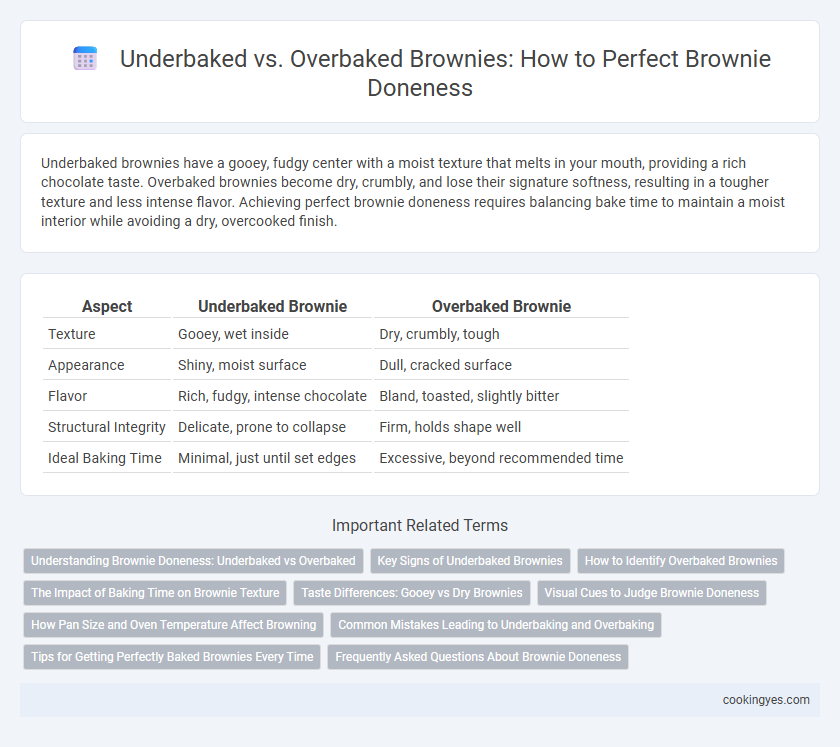Underbaked brownies have a gooey, fudgy center with a moist texture that melts in your mouth, providing a rich chocolate taste. Overbaked brownies become dry, crumbly, and lose their signature softness, resulting in a tougher texture and less intense flavor. Achieving perfect brownie doneness requires balancing bake time to maintain a moist interior while avoiding a dry, overcooked finish.
Table of Comparison
| Aspect | Underbaked Brownie | Overbaked Brownie |
|---|---|---|
| Texture | Gooey, wet inside | Dry, crumbly, tough |
| Appearance | Shiny, moist surface | Dull, cracked surface |
| Flavor | Rich, fudgy, intense chocolate | Bland, toasted, slightly bitter |
| Structural Integrity | Delicate, prone to collapse | Firm, holds shape well |
| Ideal Baking Time | Minimal, just until set edges | Excessive, beyond recommended time |
Understanding Brownie Doneness: Underbaked vs Overbaked
Underbaked brownies feature a moist, gooey center with a fudgy texture, ideal for those who prefer a rich, melt-in-your-mouth experience. Overbaked brownies tend to be dry, crumbly, and overly firm, losing the signature dense chewiness that defines perfect doneness. Achieving optimal brownie doneness requires precise baking time and temperature control to balance a crisp outer crust with a soft, tender interior.
Key Signs of Underbaked Brownies
Underbaked brownies have a noticeably glossy, wet surface with a dense, fudgy center that easily sticks to the toothpick without fully setting. The edges appear soft and slightly puffed, lacking a firm structure, while the aroma remains intensely chocolatey but slightly raw. This underbaking results in a rich, gooey texture preferred by many but requires careful cooling to avoid collapsing.
How to Identify Overbaked Brownies
Overbaked brownies exhibit a dry, crumbly texture and have a noticeably tough crust with fewer cracks on the surface compared to perfectly baked brownies. The edges become excessively hard and may pull away from the pan, while the center lacks the characteristic fudgy or chewy consistency. Detecting slight color changes to a deeper brown tone and an overall matte finish can also help identify overbaked brownies.
The Impact of Baking Time on Brownie Texture
The impact of baking time on brownie texture is crucial, as underbaked brownies retain a fudgy, moist center with a gooey consistency, while overbaked brownies become dry, crumbly, and cakey. Precise timing ensures the ideal balance between a slightly gooey interior and a firm, chewy crust, enhancing the overall sensory experience. Monitoring oven temperature and using a toothpick test can help achieve perfect doneness, preventing undesirable texture variations.
Taste Differences: Gooey vs Dry Brownies
Underbaked brownies offer a rich, gooey texture with intense chocolate flavor, delivering a moist, fudgy experience that melts in your mouth. Overbaked brownies become dry and crumbly, losing moisture and resulting in a denser, less flavorful bite. Achieving the perfect bake balances gooey richness with a slightly firm exterior for optimal taste and texture.
Visual Cues to Judge Brownie Doneness
Underbaked brownies display a glossy, wet center with edges that appear soft and slightly jiggly, indicating insufficient cooking. Overbaked brownies have dry, cracked surfaces and pull away from the pan edges, often resulting in a crumbly texture. Optimal brownie doneness is marked by a matte finish with firm edges and a slightly soft, fudgy center that holds its shape when sliced.
How Pan Size and Oven Temperature Affect Browning
Baking brownies in a larger pan leads to thinner batter layers that cook faster, increasing the risk of overbaking and excessive browning, while smaller pans yield thicker layers that may remain underbaked if not cooked long enough. Oven temperature plays a critical role; higher temperatures accelerate browning reactions such as Maillard and caramelization, making brownies darker and potentially drier, whereas lower temperatures slow these processes, often resulting in less browning but a moister interior. Precise control of pan size and oven temperature is essential to achieve the ideal balance of a fudgy, evenly baked brownie with rich, golden-brown crust.
Common Mistakes Leading to Underbaking and Overbaking
Common mistakes leading to underbaked brownies include using an inaccurate oven temperature and shortening the recommended baking time, resulting in a gooey, unset center. Overbaking often occurs when ignoring visual cues like pulling away from the pan edges or a firm top, causing dry, crumbly brownies. Properly monitoring internal temperature around 190degF (88degC) ensures ideal doneness and texture.
Tips for Getting Perfectly Baked Brownies Every Time
Achieving perfectly baked brownies requires precise timing and temperature control, typically baking at 325degF to 350degF for 20-30 minutes depending on pan size and recipe. Underbaked brownies appear moist and fudgy with a slightly gooey center, ideal for those who prefer a chewy texture, while overbaked brownies turn dry and crumbly, losing their signature richness. Using a toothpick test that comes out with moist crumbs but no wet batter ensures optimal doneness, resulting in a balanced, decadent treat every time.
Frequently Asked Questions About Brownie Doneness
Underbaked brownies often have a fudgy, moist center with a gooey texture, while overbaked brownies become dry, crumbly, and less flavorful. To determine the perfect doneness, insert a toothpick; it should come out with a few moist crumbs rather than wet batter or completely clean. Experts recommend baking brownies at 325degF to 350degF for 20 to 30 minutes, depending on pan size and recipe, to achieve optimal texture.
Underbaked vs Overbaked for Brownie Doneness Infographic

 cookingyes.com
cookingyes.com